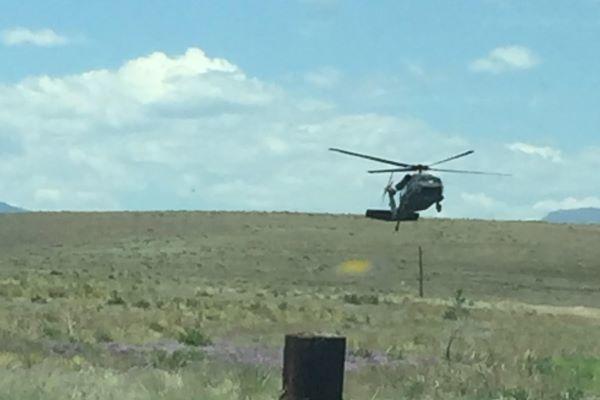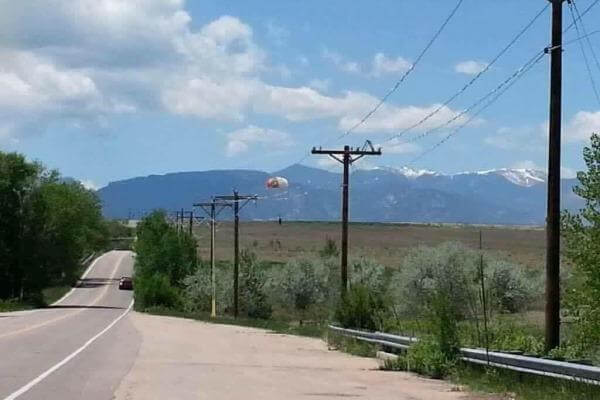TYNDALL AIR FORCE BASE, Florida -- Air Force Maj. Alex Turner has done it hundreds of times.
The F-16 Fighting Falcon pilot took off June 2, 2016, for an Air Force Thunderbirds flyover during the Air Force Academy graduation.
He was well-informed on the flying routine and communicated consistently with his teammates -- standard procedure for any flyover.
"I never approach flying … with a cocky or naive or complacent attitude because there are people out there who think bad things aren't going to happen, whereas I am the opposite -- prepare for the worst hope for the best," Turner said during an interview.
Military.com sat down with Turner, caught up with members of the team and even took a ride in an F-16D two-seater on April 21.
Turner recounted details of that fateful flyover.
He said that as he was headed back to Peterson Air Force Base, Colorado, something wasn't right.
"What was that that I just felt there, with my hand?" Turner questioned at the time of the infamous mishap that occurred minutes after the graduation flyover. Then-President Barack Obama was attending the event.
RELATED: Thunderbirds Gearing Up for First Overseas Trip in Years
Turner said soon after his left hand felt the "not normal" throttle move, he saw his engine spooling down. He remembers that as the revolutions per minute wound down, it got quiet.
As the jet descended, Turner attempted to restart the engine, but officials said it was "impossible" at such a low altitude.
"After that, it's a breath or two, and you start taking action," he said. Even as his pulse increased a bit, his years of training kicked in and he knew he had to bail.
Delaying his ejection, Turner aimed the jet at an unpopulated field two miles south of Peterson. When he did eject, he sustained minor injuries. He was recovered by local first responders.
The loss of the aircraft cost $29 million, with no additional damage to civilian property.
Turner knew he hadn't run out of gas as analysts and aviation enthusiasts previously speculated.
"That was never a thought at all," Turner said. The Accident Investigation report noted the aircraft had 900 pounds of fuel on board at the time of the crash, still a safe level of fuel to have before returning back to the flightline.
He said that as pilots observe they're at 1,200 pounds of fuel, it's a signal to initiate their last moves before initial landing sequence. An "emergency fuel state" is when the plane is carrying only 800 pounds, he said.
The official investigation later found that an accidental throttle rotation led to a malfunction and subsequent engine stall, causing Turner's No. 6 jet to crash.
RELATED: Faulty Throttle Contributed to Thunderbirds Crash: Report
The throttle trigger became stuck in the position, due to "debris accumulation in the throttle trigger, combined with wear on the trigger assembly," the report said. Without the throttle, the engine cut off and immediately lost thrust, it said.
Within days, the Thunderbirds sounded the alarm for all F-16 squadrons to inspect the jets' throttles.
"It's not common for this platform, but it has occurred before," said Lt. Col. Jason Heard, the commander and leading pilot of the air demonstration team.
"We have a safety center in Albuquerque, New Mexico, and they will make sure those lessons get translated to the entire fleet. And in fact, they've already put out guidance on this particular issue, in terms of new ways to do maintenance and also to the pilots about some new checks," he said.
A typical maintenance day for the team is roughly three hours of maintenance and pre-flight checks per aircraft as well as three hours of maintenance after an aircraft returns to the flightline, said Capt. Sara Harper, the Thunderbirds public affairs officer.
Each jet has two dedicated crew chiefs, in addition to standby maintenance airmen for each specific system.
Additional precautions -- such as an extra maintenance check from both the maintainers and pilots to an actual mechanical replacement -- were taken. Air Combat Command didn't specify what certain F-16 squadrons do by press time.
In less than a year since the accident occurred, extra inspections "have already been fully instituted," Heard said.
Heard said even before separate safety and accident investigation results were completed, maintenance crews were inspecting the entire fleet.
"We already had guidance for [pilots and crews] checking this thing," he said.
This year, Turner is flying the No. 5 jet as the lead solo pilot. The No. 6 jet is the opposing solo. As their titles suggest, these two fly together each airshow.
For the last two years, Turner has been the safety officer on the team, checking in with his teammates on a daily basis to make sure they're in tiptop shape to fly -- physically, emotionally and otherwise.
That job and the mishap have reminded him to think about the unknowns that pose risk to pilots in any capacity -- whether a part of a demonstration team or in combat.
"Regardless of the actions we can or cannot take as an Air Force depending on the context -- sometimes it's a pilot problem, sometimes it's a mechanical problem … a logistics problem -- I've always tried to defend against that, to be ready, and to make some kind of habit pattern of my own to prevent that.
"There are things that you know could happen … but it more opens your mind, I guess, toward the unknown with the jets getting older -- who knows what kind of thing we don't have a checklist for," he said.
"It makes you think … all those situations that you could imagine, but [at the same time] almost can't, and how do you deal with that? How do you prepare for that as a professional? How do you accept that as a risk that is a part of the job that one does?" he said.
RELATED: Will the F-35 Be the Next Thunderbirds Jet?
Turner anticipates attending intermediate developmental education before he puts an application in to transition to the F-35 Joint Strike Fighter.
"I'm interested in the future. I'm interested in the technology and the capabilities that [the F-35] brings -- I think it will be a new challenge," he said.
"It's less a stick-and-rudder avionics challenge, but almost more of bigger mindset shift to open your mind to this whole new way of deploying a fighter," Turner said.
Moving on from the incident, Turner said he's glad "that nobody got hurt."
"It's just a feeling of a heightened awareness for things because now, as a second-year member of the team, I've seen a year of challenging situations.
"We're a pretty tight team. And we've got to be ready," he said.
-- Oriana Pawlyk can be reached at oriana.pawlyk@military.com. Follow her on Twitter at @Oriana0214.






























